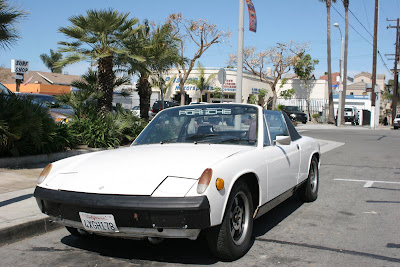1. Lack of motor noise
The gas car is too loud, e.g., descending
page mill road in 2nd gear. I want volume control.
2. Lack of manual engine braking
In the white car (1.8L fuel-injected 5 speed), 3rd gear is good from about 25 to 50 mph. The top half of the range (4000-6000 RPM) gives hard acceleration and hard engine braking. The bottom half of the range accelerates/brakes slowly. If you're driving around curves with 30 mph signs, 3rd gear is very responsive. If you're driving around curves with 20 mph signs, you want 2nd gear, and so on. Engine braking is more extreme (and louder) in lower gears.
I read the "Interface Document" for my AC-150 Gen 1 electric system. Above 2000 RPM (around 20 mph in 3rd gear), pedal depression below 30% initiates regenerative braking, with stronger braking as pedal depression drops to 0%. A slider on the instrument panel determines the slope of the pedal-response from 0-30%. The slider replaces your transmission for manual engine braking.
Unfamiliar braking is not only un-fun, it's dangerous. Regenerative braking easily surprises new drivers and can cause loss of traction in slippery conditions.
3 Traction control (not a problem)
The AC-150 also includes inputs for traction control. A wheel-speed sensor is installed on each of the non-drive wheels (i.e., the front wheels of a rear-wheel drive car), which supplies rotation speed information to the power electronics unit (PEU). When the speed of the drive wheels is under/over a threshold, determined by the average non-drive wheel speed, the motor enters traction control by attempting to match the RPM of the drive wheels with the non-drive wheels.
4 Transmissions (interlude)
The gear shifter is still connected to the transmission, but the (electric) car has no clutch. The motor is coupled directly to the transmission through an insulating material (b/c the motor shaft, which is made of copper, cannot contact the transmission, which is grounded to the chassis).
The Porsche 914 has a synchronized manual transmission. When you depress the clutch of a manual transmission and shift into neutral, the transmission input (motor) and output (drive) shafts are decoupled. The wheels continue spinning the drive shaft, and with the clutch depressed, the transmission input shaft spins freely. The brass synchronizer gears help engage new gearing as the two shafts spin at different speeds (
read more).
5 Ideas for voiding warranty (override traction control)
Without a clutch, shifting into neutral appears the same a loss of traction to the PEU, which will attempt to spin the motor the same speed as the wheels are spinning
in the gear it was calibrated for.
With the shifter in neutral, adjust motor speed for the next gear by overriding the traction control inputs?




